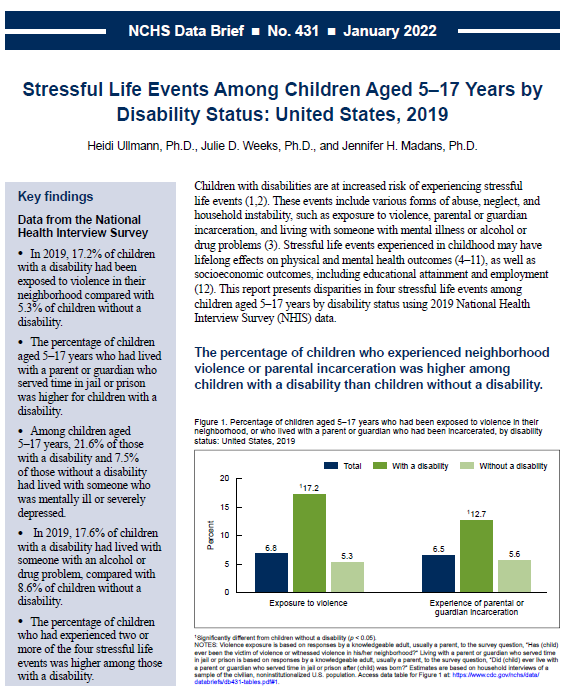Stressful Life Events Among Children Aged 5–17 Years by Disability Status: United States, 2019
Posted on by
Questions for Heidi Ullman, Health Statistician and Lead Author of “Stressful Life Events Among Children Aged 5–17 Years by Disability Status: United States, 2019.”
Q: Why did you decide to do a report on stressful life events for children with a disability?
HU: Children with disabilities are an important population group that has experienced disadvantage in many domains. We were interested in seeing if children with disabilities were at increased risk of experiencing stressful life events as these events have been linked to adverse physical and mental health outcomes. Identifying the extent to which children with disabilities are at increased risk will inform policy to support these children and promote their health and full inclusion in society.
Q: What is considered a disability for this report?
HU: We adopt a functional approach to disability consistent with international standards for disability measurement. Disability in children aged 5-17 years is defined by the reported level of difficulty (no difficulty, some difficulty, a lot of difficulty, or cannot do at all/unable to do) in thirteen core functioning domains: seeing, hearing, mobility, self-care, communication, learning, remembering, concentrating, accepting change, controlling behavior, making friends, anxiety and depression. Children reported to have “a lot of difficulty” or “cannot do at all” to at least one domain of functioning or with “daily” anxiety or depression are considered to have disability.
Q: Can you describe what the four stressful life events that are examined in the report?
HU: Four stressful life events are considered: 1) ever been the victim of, or witnessed, violence in the neighborhood, 2) ever lived with a parent or guardian who served time in jail or prison (after the child was born), 3) ever lived with someone who was mentally ill or severely depressed, and 4) ever lived with someone who had a problem with alcohol or drugs. It should be noted that these four stressful life events represent a subset of a larger set called Adverse Childhood Experiences (ACEs).
Q: How does the data vary by disability status when looking at the four stressful life events examined in this report?
HU: Among children aged 5-17 years, those with a disability were more likely than those without a disability to have experienced each of the four stressful life events examined in this report. The differences by disability status were greatest for violence exposure in the neighborhood and having lived with someone who was mentally ill or severely depressed. Moreover, disability status was associated with experiencing multiple stressful life events in children.
Q: What is the take home message in this report?
HU: The take home message is that children with a disability are more vulnerable to experiencing stressful life events, the impacts of which may curtail their full participation and inclusion in society. More generally, our results point to the importance of considering disability status when analyzing health disparities.
Posted on by

